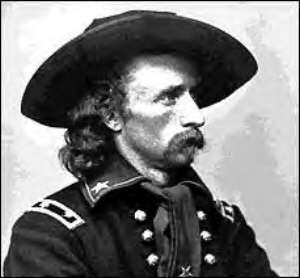Bay Cityans Were In the Saddle As Custer Immortalized the Wolverines
|
||||||||||
| Printer Friendly Story View |

Fierce wolverine had never been sighted in Michigan until a year ago in Ubly, Michigan, a small town in the Thumb.

Gen. George Armstrong Custer was originally from Ohio and perhaps picked up the nickname for Michigan soldiers persisting from the tales of the Ohio "war" in 1803.
Sixteen-year-old Johnny Phillips rushed out of Bay City's one room school house on Washington Avenue near Columbus.
Fresh-faced Johnny hustled to Detroit and enlisted in Company H, First Michigan Cavalry. He became the unit's youngest recruit.
It was 1861. Confederates had bombarded Ft. Sumter and brash youth in Bay City as all over the north were rushing to enlist.
Bay City's role in national history continues to be uncovered by historians.
In a recent presentation on the Birney family to the 7th Michigan Cavalry Civil War Round Table (CWRT), several key points arose.
1) Bay City soldiers were highly involved at Gettysburg, one of the Civil War's most crucial battles.
2) Major Generals David and William Birney, both of whom had lived in Bay City, recruited and led units of the U.S. Colored Troops in key battles that helped turn the tide of the war.
3) President Abraham Lincoln personally made sure that David Birney, an abolitionist like his well-known father, James Gillespie Birney, was promoted to major general.
The local history study group adopted the 7th Cavalry because Capt. James G. Birney IV, who enlisted from Bay City, was one of the unit's heroes.
Tim Younkman of The Bay City Times is the next presenter at the CWRT at 7 p.m. Wednesday, Feb. 16 at Messiah Lutheran Church, 501 S. Catherine St. He will speak on an obscure Bay Cityan who was a key figure in management of railroads for the Union Army.(Call 892-1136 for information.)
Several other Bay Cityans were members of the Michigan Cavalry Brigade that included the 7th.
New research finds that the 7th, the smallest and least experienced of the units in the Michigan Cavalry Brigade, led key charges against J.E.B. Stuart's Confederates.
The Rebels desperate last ditch drive to turn the Union line on July 3 threatened to reverse the course of the battle of Gettysburg and perhaps the outcome of the war.
The 19-year-old Birney was wounded, captured and escaped in the tumult and was promoted by Custer for heroism.
The most famous individual battle cry of the Civil War mayhave been George Armstrong Custer's "Come on, you Wolverines!" delivered in that famous charge.
That call to action was issued by the flamboyant Custer at the head of Michigan's cavalry in a crucial charge near Gettysburg against Stuart's gray-clad mounted troopers.
Did Custer originate the idea that Michiganians are called Wolverines? And did that connection result in the wolverine being adopted by the University of Michigan athletic teams?
It seems that in aroundabout way the appellation "Wolverines" was attached to Michiganians by Ohioans, but not Custer originally.
During the border dispute between Michigan and Ohio in 1803, commonly called "the Toledo War," Michigan partisans gained the name wolverines. Perhaps it was mockingly applied because of the wolverines gluttonous habits, maybe because the Ohioans thought their land was greedily being appropriated. Or perhaps the Michigan folks used the name themselves to show their tenacity and strength in the argument over the boundary line.
A related theory arises in connection with the study of the Michigan Cavalry Brigade, which Custer headed so heroically at Gettysburg.
University of Michigan students had been calling themselves "Wolverines" beginning as early as 1861, the year the Civil War broke out.
A group of former U-M students, including James Harvey Kidd, of Ionia, Michigan, were among the early recruits to the First Michigan Volunteer Cavalry headed by Col. Thornton Brodhead of Detroit.
Kidd and his fellow Wolverines from the U-M had been inspired by a speech by university chancellor Henry P. Tappan. Shortly after the Confederate artillery attack on Ft. Sumter, Dr. Tappan said at a campus rally in support of the war effort that the university would place no obstacle in the path of students who wished to enlist, "but on the contrary would bid them God sped and watch their careers with pride and solicitude."
Kiddjoined one of several quasi-military units on campus, was elected second lieutenant and began studying tactics and drilling. He soon enlisted and joined the unit in training at the old Hamtramck Race Track near Detroit.
The 862 men of the Michigan Cavalry Brigade entrained for Washington on Sept. 28, 1861. Their sendoff included flowery speeches and flag presentations by politicians.
Campaigning in the Shenandoah Valley, the Michigan cavalry dealt the legendary rebel cavalryman Turner Ashby and the Stonewall Jackson Brigade their first defeat.
Following the collapse of the Peninsula Campaign in 1862, President Lincoln put out a call for 300,000 more men. "We are coming, Father Abraham, 300,000 strong," was thesong that resonated from Detroit where it originated.
Kidd won a captaincy in a recruiting competition, signing up scores of his U-M friends in Co. E, Sixth Michigan Cavalry.
Meanwhile, Custer was angling for an action command. Michigan Gov. Austin Blair had spurned Custer's application for colonelcy of the 7th. However, Gen. Alfred Pleasanton, almost as flashy a character as Custer, convinced Gen. George Gordon Meade to make Custer a brigadier general heading the entire Michigan Cavalry Brigade, the only Union cavalry unit whose regiments all hailed from the same state.
Custer was in command just in time to head the Michigan troops on June 30, 1863 at Hanover when Stuart's raiders arrived seeking Lee's main body. The fateful battle with the Wolverines kept the two legendary Confederates from linking up, and prevented Lee from obtaining information of the whereabouts and size of the Union troops.
Ironically, Bay City's young James G. Birney IV, with the 7th Cavalry, clashed at Hanover with his cousin, C.S.A. Brig. Gen. Fitzhugh Lee, nephew of Robert E. Lee.
The were to meet again on the same field July 3. As Fitz Lee and the First Virginia attacked the Union rear, Custer reined inat the head of the 7th, ordered his 500 men to draw sabers. He was heard, above the thunder of hooves, to shout: "Come on you Wolverines" and the dashing Michigan cavalry over-ran the enemy.
It was about 3:30 p.m. and over on the main Gettysburg battlefield, 13,000 Confederates were about to launch an advance known as the fateful "high water mark of the Confederacy."
Custer regrouped his scattered cavalry units and made another charge, the monumental clash with Wade Hampton's Legion said to have sounded like "the falling of timber."
Remnants of the 7th Michigan followed Col. Russell Alger, later governor, in his regiment's fourth advance of the day.
The importance of the day's action is put intoperspective by author Edward G. Longacre of "Custer and His Wolverines," (Conshohocken, PA, Combined Publishing, 1997):
"Stuart would not reach the Union rear in time to salvage the doomed attack against Meade's center that would become known as Pickett's Charge. And for that outcome, Custer's Wolverines could claim a heroic share of the credit."
Later that fall, at Brandy Station in another clash with Stuart, Custer was more vehement, according to author Longacre. As he spurred the Michigan cavalry charge, he was heard to mutter, "Come on you Wolverine s.o.b.'s; give 'em hell!"###
| Printer Friendly Story View |
|
|

Dave Rogers |
|
|
|
Printer-Friendly Story View
0200 Nd: 04-15-2024 d 4 cpr 0
12/31/2020 P3v3-0200-Ad.cfm
SPONSORED LINKS
12/31/2020 drop ads P3v3-0200-Ad.cfm


